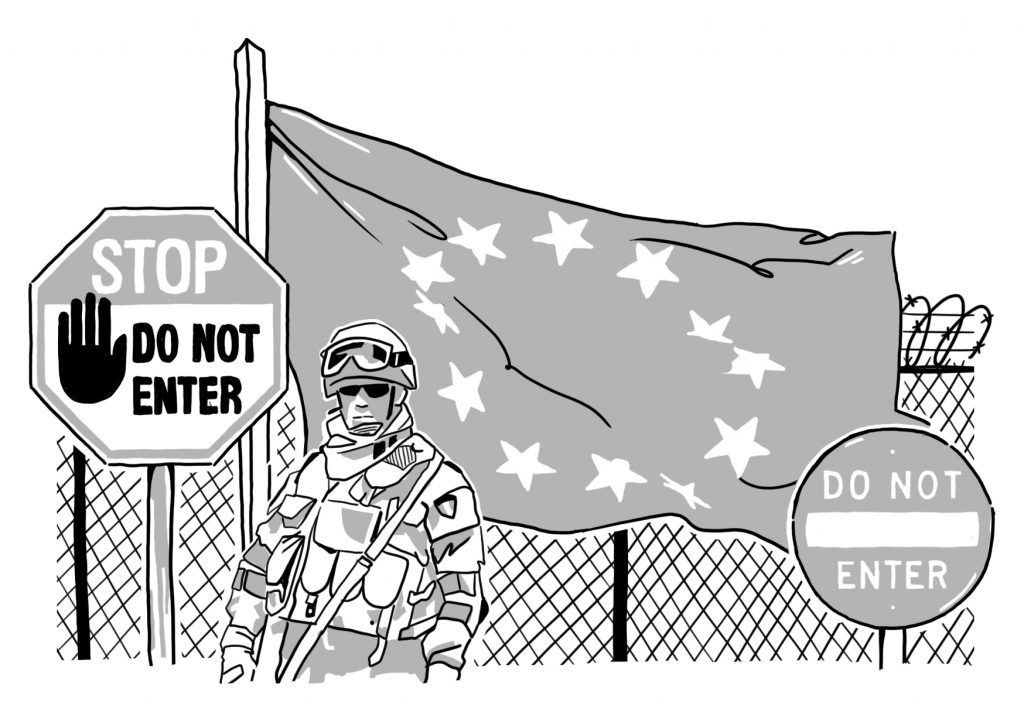Content Warning: Sexual Violence
The word ‘asylum,’ like many others, entered the English language from Greece. Its origin, ‘asylos’ means inviolable, or literally, an inviolable place. Useful and broad, the word evolved to describe different situations throughout time. One of the most well-known practises of asylum-seeking throughout history involved accused criminals seeking sanctuary in foreign nations. This transnational use of asylum-seeking was not necessarily the norm, however. Political sanctuary was just one facet of the practise. Granting asylum was often a religious custom, associated more closely with places of worship than nation-states. In the Middle Ages and Early Modern period, local institutions to house orphans sprung up globally and were named asylums. In the 18th century, asylum was legally defined as a benevolent institution, originally for female orphans, to shelter some class of persons suffering social, mental, or bodily defects. So-called lunacy asylums were common in Europe at this time, purporting (although likely not succeeding) to offer refuge to the mentally ill.
It was only in the 20th century that the asylum system began to bear some resemblance to what is happening today. The mass movement of Jewish and other minority groups fleeing the Holocaust gave rise to the need to formulate an international apparatus to protect these people. This was achieved in 1951 when the UN Convention Relating to the Status of Refugees founded the modern legal refugee system. The word asylum delineated vastly different circumstances throughout history. The one thing they share is the promise of security, a space free from violation, to vulnerable people.
The idea of an inviolable space implicates homeliness, security, even domesticity. These concepts bear a particular significance for women. Historically, men have been able to operate in two distinct spheres of life – public and private. For women, it has not been so simple. As women both reigned over and were chained to the domestic world, the lines between public and private, vulnerable and safe, were much more blurred. The accompanying lack of autonomy women could exercise over all aspects of their lives, elevates the idea of an inviolable space to an almost utopic ideal beyond the gendered existence. Forced displacement is the product of the complete, cataclysmic violation of space. It is obvious to the point of ineffability that a true system of asylum offers a respite from violation.
The Asylum System Today
Europe’s asylum reception centres do not offer this respite. The current global asylum system is ruthless. After fleeing war, persecution, economic peril, or some combination of the three, thousands of asylum seekers undergo grave danger every year to reach the European Union (EU). Due to its position on Europe’s external border, many refugees from Syria, North Africa, and elsewhere perceive Greece as a gateway to Europe. As a result, the country has seen a disproportionate surge in the number of asylum seekers arriving over the last ten years compared to other European states. In 2010, Greece received 10,273 first time asylum applications. By the end of 2019, the country was host to approximately 186,200 refugees and asylum seekers.
Many of these refugees arrived in the hope that they would be soon moved to other European countries. Mounting numbers of arrivals coupled with political disagreements between EU nation states significantly stalled this process, leaving many people stuck. Currently, conditions in Greece’s asylum centres are dire. Originally intended to operate as short-term residences, refugee camps have become detention centres where asylum seekers spend months, even years at a time. The 2016 EU-Turkey migration agreement is one of the key factors driving these brutal conditions. As part of the deal, Turkey agreed to take back asylum seekers whose applications have been rejected from Greece. In exchange, the EU would take one refugee from Turkey for every one sent back from the Greek islands. While asylum seekers wait for their applications to be processed, they are subject to a geographical restriction, prohibiting travel to mainland Greece. Asylum claims can take up to two years to process, producing a huge population of refugees in perpetually worsening conditions.
Although the agreement emphasised “the urgent need to address gender-related violence and abuse against women and girls on the migrant routes crossing Turkey”, the promises of the pact have not been fulfilled. Moreover, the agreement failed to reckon with the rampant gender-based violence within the camps themselves.
The Moria refugee camp on the island of Lesbos, originally intended to house up to 3,000 refugees, was housing at least double that capacity in 2018. Resources became so stretched that residents spent up to twelve hours a day queuing for food and water. Reports from the Vathy camp confirm that there are more than 3,800 living in the camp, almost six times its capacity. Overcrowding and the subsequent lack of privacy causes a life pervaded by violations of the domestic world. No doubt, these conditions are bleak for everyone. For women, however, a further acute risk is posed – sexual gender-based violence (SGBV). 1
Women in Greece’s refugee camps are continuously subject to sexual harassment and exploitation. Some have said that the extent of the issue is such that they are afraid to leave their tents without their husbands. Sanitation facilities often do not have sufficient lighting or locks and in Moria there was approximately one toilet and shower per 80 people. Toilet facilities after dark have been called “no-go zones” for unaccompanied women. In some camps, the risk of sexual violence is so high that many women are too “scared to take a shower”. One woman living in Moria told a UNHCR spokesperson that the danger was so potent that she had not showered for two months.
The Data Gap
Although there is consensus that SGBV is widespread in Greece’s camps, it has been difficult to assess its prevalence precisely. Reasons for this are plentiful, including diverging definitions of sexual violence across academia, the sensitivity of the topic, cultural norms, and importantly, lack of guaranteed safety among the participants. Furthermore, the camps in Greece lack security and women are afraid to report sexual violence or assault cases. Many fear if they report, the aggressor will attack them again. It is estimated that more than 90% of sexual and gender-based victimisation cases in the refugee context are not reported.
Studies in equivocal refugee camps in Europe can give us an insight into the scope of the problem. ‘Hidden violence is silent rape: sexual and gender-based violence in refugees, asylum seekers and undocumented migrants in Belgium and the Netherlands’ was written by the experts in sexual violence, health, and refugees, Ines Keygnaert, Marleen Temmerman, and Nicole Vettenburg. Here, the demography of perpetrators sheds further light on the fallacy of inviolable space for refugee women. Studies in Belgium and the Netherlands have shown that most victims knew the perpetrator; in 31% of cases, it was an intimate partner, a family member in 16%, an acquaintance in 15%, and in 12% a stranger. More than one in five cases were reported to be a service provider like security guards, lawyers, and police. These are professionals tasked at the most basic level with safeguarding the welfare of refugees. This flagrant abuse of power is so acute that any comment on it feels tautologous. It is shameful and must be reckoned with.
Prevention
How then should prevention measures be implemented? Perhaps gender-sensitive infrastructure could help mitigate sexual violence in sanitation facilities. If refugee women were consulted about the design and location of showers and toilets, it seems intuitive that the facilities would work better for them. It could reduce design oversights that could be prevented if the facility designers were the same people as users. More numerous and smaller sanitation facilities dispersed around the camps could mean that women must not walk for long periods in the dark to shower or use the toilet. With women reporting simple issues like inadequate lighting or missing locks on doors as SGBV risks, the value of consciously designed infrastructure cannot be overstated.
Including refugee women in facility design may seem overly idealistic to some policymakers. Certainly, resources in these camps are already stretched to breaking point. Nonetheless, the current system is inoperable. In some locations, infrastructure will have to be fully rebuilt regardless of these perceived obstacles. The fire that ravaged Moria camp in September 2020 saw the total destruction of all its facilities. In December, more than 7,000 people remained in emergency accommodation, months after the fire rendered them homeless. Given that accommodation for these refugees and more must be built anyway, consulting women about facility design seems an obvious, inexpensive way to mitigate SGBV.
However, this will not help prevent sexual violence in domestic settings. With 47% of (reported) SGBV instances perpetrated by an intimate partner or family member, an approach that exclusively fortifies the public sphere simply misses the point. Sexual violence takes place at the cross-section between public and private, in such a way that renders acknowledgement of one without the other impossible. No doubt, reconciling this dichotomy will be complicated, but moral imperatives usually are.
The fire that razed Moria to the ground last year shattered the residuals of our delusions that our spaces of asylum are safe. The epidemic of SGBV in Greece’s refugee camps is also a testimony to this. Sexual violence in the refugee context is not inevitable. Mitigation policies can and must be implemented. If the European Union cannot prevent mass sexual violence on its territory, why suggest the system it offers is asylum at all?
1 The author acknowledges that there are many other forms of sexual violence occurring both in the asylum sector and out of it. This article has focused just on sexual violence against women.
Sinéad Barry is a 2022 Master of Public Policy candidate at the Hertie School. She holds a Bachelor’s degree in English literature and Philosophy from Trinity College Dublin, where she specialised in creative writing. Sinéad has previously worked as a journalist and is interested in migration issues, gender equality, and climate justice. She loves to read, walk, and wear excessively colourful jumpers.

